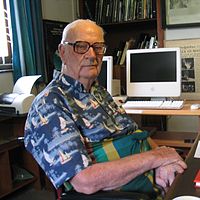Deaths

- 12 January – Howard Dalton (b. 1944), British microbiologist.
- 11 February – Norbert Pfennig (b. 1925), German microbiologist.
- 5 March – David Challinor (b. 1920), American biologist, naturalist, and scientific administrator at the Smithsonian Institution.
- 11 March – Howard Gobioff (b. 1971), American computer scientist.
- 19 March – Arthur C. Clarke (b. 1917), British science fiction author, futurist and inventor.
- 8 April – Graham Higman (b. 1917), British mathematician.
- 13 April – John Wheeler (b. 1911), American theoretical physicist, coined the terms black hole and wormhole.
- 16 April – Edward Norton Lorenz (b. 1917), American mathematician and meteorologist, coined the term butterfly effect.
- 29 April – Albert Hofmann (b. 1906), Swiss chemist, synthesizer of LSD.
- 15 May – Willis Lamb (b. 1913), American physicist, winner of the 1955 Nobel Prize in Physics.
- 20 May – Jürgen Ehlers (b. 1929), German physicist.
- 15 June – Arthur Galston (b. 1920), American botanist and bioethicist.
- 22 July – Victor A. McKusick (b. 1921), American geneticist, known as the "Father of Genetic Medicine".
- 5 August – Neil Bartlett (b. 1932), British chemist who prepared the first compound of a noble gas.
- 23 August – Thomas Huckle Weller (b. 1915), American virologist and co-winner of the 1954 Nobel Prize in Physiology or Medicine for his work on polio.
- 8 September – Ruxandra Sireteanu (b.1945), Romanian neuroscientist. [48]
- 8 October – George Emil Palade (b. 1912), Romanian cell biologist, winner of the 1974 Nobel Prize in Physiology or Medicine, discoverer of the ribosomes of the endoplasmic reticulum.
- 10 November – George Rédei (b. 1921), Hungarian biologist.
- 14 November – Adrian Kantrowitz (b. 1918), American cardiac surgeon.
- 30 November – Ralph A. Lewin (b. 1921), Anglo-American biologist, known as "the father of green algae genetics".
- 12 December – Daniel Carleton Gajdusek (b. 1923), Hungarian-Slovak-American physician, winner of the 1976 Nobel Prize in Physiology or Medicine, famous for his work on kuru, the first human prion disease demonstrated to be infectious.